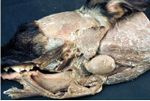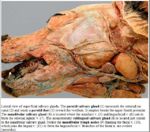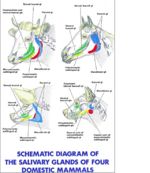Difference between revisions of "Salivary Glands Overview - Anatomy & Physiology"
Jump to navigation
Jump to search
m (Text replace - "Serous Salivary Gland - Anatomy and Physiology" to "Serous Salivary Gland - Anatomy & Physiology") |
m (Text replace - "Oral Cavity - Tongue - Anatomy & Physiology" to "Tongue - Anatomy & Physiology") |
||
| Line 3: | Line 3: | ||
The [[Oral Cavity Overview - Anatomy & Physiology|oral cavity]] is drained by numerous salivary glands. The saliva secreted keeps the mouth moist and facilitates [[Mastication|mastication]] by lubricating the passage of the bolus. | The [[Oral Cavity Overview - Anatomy & Physiology|oral cavity]] is drained by numerous salivary glands. The saliva secreted keeps the mouth moist and facilitates [[Mastication|mastication]] by lubricating the passage of the bolus. | ||
| − | Salivary gands are present in the [[Cheeks|cheek]], [[ | + | Salivary gands are present in the [[Cheeks|cheek]], [[Tongue - Anatomy & Physiology|tongue]], [[Lips|lips]], [[Oesophagus - Anatomy & Physiology|oesophagus]], [[Soft Palate|soft palate]] and [[Pharynx - Anatomy & Physiology|pharynx]] but the major salivary glands are located further away from the [[Oral Cavity Overview - Anatomy & Physiology|oral cavity]] and function through connective ducts. |
Saliva provides digestive enzymes, is a route of excretion of substances which accumulate on the [[:Category:Teeth - Anatomy & Physiology|teeth]] and provides lubricative and also cleansing functions. | Saliva provides digestive enzymes, is a route of excretion of substances which accumulate on the [[:Category:Teeth - Anatomy & Physiology|teeth]] and provides lubricative and also cleansing functions. | ||
Revision as of 17:08, 4 September 2010
Introduction
The oral cavity is drained by numerous salivary glands. The saliva secreted keeps the mouth moist and facilitates mastication by lubricating the passage of the bolus.
Salivary gands are present in the cheek, tongue, lips, oesophagus, soft palate and pharynx but the major salivary glands are located further away from the oral cavity and function through connective ducts.
Saliva provides digestive enzymes, is a route of excretion of substances which accumulate on the teeth and provides lubricative and also cleansing functions.
Salivary glands can produce a serous secretion, a mucous secretion or both.
Types of Salivary Glands
Major Salivary Glands
- Parotid (glandula parotis)
- Mandibular (glandula mandibularis)
- Sublingual (glandula sublinguales)
- Zygomatic (glandula zygomatica)
Minor Salivary Glands
Innervation
- Sympathetic
- Vasoconstriction occurs
- Flow of saliva is decreased
- Parasympathetic (most important)
Saliva
- Mainly water
- Amylase for carbohydrate digestion
- Salt- mainly sodium bicarbonate
- Mucin
- Electrolytes
- Antimicrobial agents
- Lingual lipase
Species Differences
Equine
- Produce up to 40L per day
Bovine
- Produce 110-180L per day
Porcine
- Produce up tp 15L per day


